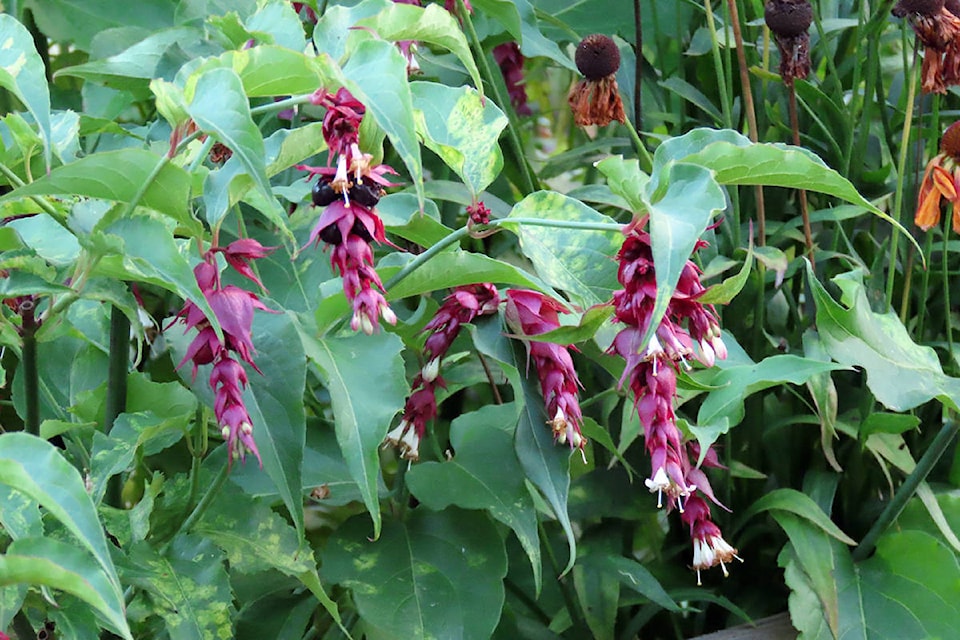Leslie Cox
Special to The Record
Last column, I did not get very far down my list of notable “garden tough” plants in our garden, which are still displaying stellar traits right now. Carrying on…
Two vines deserving mention: Clematis ‘Princess Diana’ and Lonicera periclymenum (common honeysuckle).
Cannot say enough about Clematis ‘Princess Diana.’ Sometimes sold as Clematis ‘The Princess of Wales’, this cross between C. texensis and C. ‘Bees Jubilee’ has climbed above its purported eight-foot height in our garden and is a mass of pretty pink flowers beyond its June to September bloom period. Draped around the swallow house and stretching over the pergola, it is a lovely display enjoyed from the kitchen windows above as well as from ground level. With masses of flower buds still to open, we are guaranteed a floral display until a good frost hits our garden. (which was Oct. 9 in 2019.)
As for the honeysuckle, this is the first time its second bloom has covered almost the entire vine. It looks amazing! Mind you, there is little to no scent this time around but who has time to sit on the bench underneath it in harvest season anyway? Suffice to say, the honeysuckle is delicious eye candy from the kitchen window where I am spending much of my time putting up veggies and fruits.
I also get an awesome view of John’s large clump of Miscanthus sinensis ‘Cosmopolitan’ from the same kitchen window. At eight feet tall, one really cannot miss this maiden grass’s vase-like form of luminous white and green leaf blades.
Unfortunately, this is one of the years where this grass has not produced its plumes of flowers. Seems to be hit and miss in our garden…likely tied in to when the hot summer temperatures hit. In the summer of 2019, which was hotter and started earlier, we had lovely plumes. Not missing them this year though, because the variegated leaf blades are more than capable of holding the “wow factor.”
Leycesteria formosa, Himalayan honeysuckle, is still showing off its unique blooms. Don’t let the common name fool you as this plant is not a vine but a shrub, which can grow six feet tall. Our garden is at the coldest end of its zoning so this shrub dies back every year and reappears the following spring for us. But pretty much fuss-free with no pests or diseases to speak of.
What I particularly love about this plant are the drooping chains of maroon and white flowers in mid-summer which turn into chocolate brown berries. Hence its other common name of pheasant berry. The berries are edible, tasting rather like burnt caramel…if you pick them at the right time.
This shrub is quite unique and well-deserving of its Great Plant Pick Award bestowed in 2012 by the Elizabeth Miller Botanical Garden. (This is a program which tests and awards plants suitable for growing in the Pacific Northwest: greatplantpicks.org.)
As the colour is beginning to change, I must give mention to Stewartia pseudocamellia in my garden. (Pretty sure I have mentioned this tree in previous columns.)
John insisted I needed this tree to replace a blue cedar we had taken out, even though its height was more than I really wanted. His argument of “slow-growing” won me over, although, as it turns out, it is on the fast side of the slow-growing scale to my way of thinking. But I cannot dispute his claim of stunning fall colour. One word: wow.
These colours are the last hurrahs of the year’s growing season as the garden slides its way towards winter slumber. Sad to see but what a way to end!
Leslie Cox co-owns Growing Concern Cottage Garden in Black Creek. Her website is at www.duchessofdirt.ca
